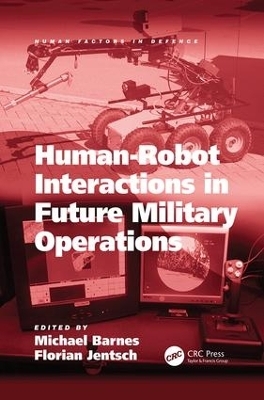
Human-Robot Interactions in Future Military Operations
CRC Press (Verlag)
978-1-138-07170-4 (ISBN)
Michael Barnes is a Research Psychologist with the US Army Research Laboratory (ARL). For the past five years, he was the lead for the human robotic interaction (HRI) program that included both military and university research as part of an Army Technology Objective: Robotic Collaboration. His past experience includes tenure with the US Navy and as a human factors manager with General Electric. Also, he has served on a number of international committees related to HRI. He has authored or co-authored over 60 articles on the human element of military systems. Located at Ft. Huachuca, AZ, his research interests include investigations of risk visualization, intelligence processes and unmanned aerial vehicles crew systems. Florian Jentsch, Ph.D., is an Associate Professor at the University of Central Florida, Orlando, with joint appointments in the Department of Psychology and the Institute for Simulation & Training. He is also the Director of the Team Performance Laboratory. He received his Ph.D. in Human Factors Psychology in 1997, and he holds master’s degrees in aeronautical science and aeronautical engineering. Dr. Jentsch is associate editor for Human Factors and for Cognitive Technology, and consulting editor for the International Journal of Applied Aviation Studies. His research interests are in team performance and training, pilot training and performance, human-robot interaction, and simulation methodology. Dr. Jentsch has co-authored over 200 publications and presentations; this is his second edited book.
Part I Introduction to HRI; Chapter 1 An Introduction to Human-Robot Interaction in Military Applications, A. William EvansIII; Chapter 2 Soldier-Robot Teams in Future Battlefields, Michael J.Barnes, A. William EvansIII; Chapter 3 The Safe Human-Robot Ratio, Robin R.Murphy, Jennifer L.Burke; Part II Foundations of HRI; Chapter 4 The Cognitive Psychology of Human-Robot Interaction, Douglas J.Gillan, JenniferRiley, PatriciaMcDermott; Chapter 5 Social Factors in Human-Robot Interaction, Lori FosterThompson, Douglas J.Gillan; Chapter 6 Robots in Space and Time, Skye L.Pazuchanics, Roger A.Chadwick, Merrill V.Sapp, Douglas J.Gillan; Chapter 7 Automation Strategies for Facilitating Human Interaction with Military Unmanned Vehicles, KerylCosenzo, RajaParasuraman, Ewartde Visser; Chapter 8 An Analytical Approach for Predicting Soldier Workload and Performance Using Human Performance Modeling, Diane KuhlMitchell, CharnetaSamms; Part III UAV Research; Chapter 9 Introductionducing Cognitive and Co-operative Automation into Uninhabited Aerial Vehicle Guidance Work systems, AxelSchulte, ClaudiaMeitinger; Chapter 10 Situation Awareness in Human-Robot Interaction, Jennifer M.Riley, Laura D.Strater, Sheryl L.Chappell, Erik S.Connors, Mica R.Endsley; Chapter 11 Imperfect Reliability in Unmanned Air Vehicle Supervision and Control, Christopher D.Wickens, BrianLevinthal, StephenRice; Chapter 12 Remotely Operated Vehicles (ROVs) from the Bottom-Up Operational Perspective, TalOron-Gilad, YanivMinkov; Chapter 13 Unmanned Aerial Vehicles, GloriaCalhoun, MarkDraper; Part IV UGV Research; Chapter 14 Telepresence Control of Unmanned Systems, ChrisJansen, Jan B F.van Erp; Chapter 15 Multimodal Research for Human Robot Interactions, Ellen C.Haas, Jan B.F.van Erp; Chapter 16 Robotics Operator Performance in a Multi-Tasking Environment, Jessie Y.C.Chen; Chapter 17 A Cognitive Systems Engineering Approach for Human-Robot Interaction, LaurelAllender, Patricia L.McDermott, JasonLuck; Chapter 18 Robotic Control Systems for Dismounted Soldiers, Elizabeth S.Redden, Linda R.Elliott; partV Cross-platform Research; Chapter 19 Lessons Learned from Human-Robotic Interactions on the Ground and in the Air, Nancy J.Cooke, Roger A.Chadwick; Chapter 20 On Maximizing Fan-Out, Michael A.Goodrich; Chapter 21 Coordination and Automation for Controlling Robot Teams, MichaelLewis, JijunWang; Chapter 22 Model World, FlorianJenstch, A. William EvansIII, ScottOsosky; partVI Future Directions; Chapter 23 The Future of HRI, A. William EvansIII, Florian G.Jentsch;
| Erscheinungsdatum | 01.07.2017 |
|---|---|
| Reihe/Serie | Human Factors in Defence |
| Verlagsort | London |
| Sprache | englisch |
| Maße | 156 x 234 mm |
| Gewicht | 453 g |
| Themenwelt | Sozialwissenschaften ► Politik / Verwaltung ► Politische Theorie |
| Technik ► Umwelttechnik / Biotechnologie | |
| ISBN-10 | 1-138-07170-6 / 1138071706 |
| ISBN-13 | 978-1-138-07170-4 / 9781138071704 |
| Zustand | Neuware |
| Haben Sie eine Frage zum Produkt? |
aus dem Bereich


